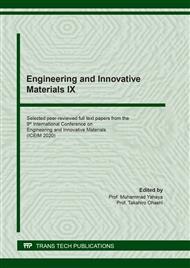[1]
WWAP (United Nations World Water Assessment Programme). 2017. The United Nations World Water Development Report 2017. Wastewater: The Untapped Resource. Paris, UNESCO.
DOI: 10.18356/b3695c8a-en
Google Scholar
[2]
Asian Development Bank. Fast Facts: Urbanization in Asia. Published: 15 Nov. (2011).
Google Scholar
[3]
S. Rezania, M. Ponraj, A. Talaiekhozani, S.E. Mohamad, M.F. Md Din, S. Mat Taib, F. Sabbagh and F. Md Sairan: J. Environ. Manage. Vol. 163 (2015), pp.125-133.
DOI: 10.1016/j.jenvman.2015.08.018
Google Scholar
[4]
S.K. Gunatilake: J. Multidiscip. Eng. Sci. Studies Vol. 1 (2015), pp.12-18.
Google Scholar
[5]
R. Gapusan and M.D.L. Balela: Mater. Chem. Phys. Vol. 243 (2020), 122682.
Google Scholar
[6]
F. Fu and Qi Wang: J. Environ. Manage. Vol. 92 (2011), pp.407-418.
Google Scholar
[7]
C.L.E. Aquino, M.J.C. Bongar, A.B. Silvestre and M.D.L. Balela: Key Eng. Mater. Vol. 775 (2018), pp.254-259.
Google Scholar
[8]
M.U. Herrera, C.M. Futalan, R. Gapusan and M.D.L. Balela: Water Sci. Tech. Vol. 78 (2018) 1137-1147.
Google Scholar
[9]
A.R. Agcaoili, M.U. Herrera, C.M. Futalan and M.D.L. Balela: J. Taiwan Inst. Chem. Eng. Vol. 78 (2017), pp.359-69.
Google Scholar
[10]
A.C. Lacuesta, M.U. Herrera, R. Manalo and M.D.L. Balela: Surf. Coat. Tech. Vol. 350 (2018), pp.971-976.
Google Scholar
[11]
M.D.L. Balela, M.M. Intila and S.R. Salvanera: Mater. Today: Proceed. Vol. 17 (2019), pp.672-678.
DOI: 10.1016/j.matpr.2019.06.349
Google Scholar
[12]
S.H. Lee, Y.G. Jeong, Y.I. Yoon and W.H. Park: Polym. Degrad. Stab. Vol. 143 (2017), pp.2017-213.
Google Scholar
[13]
M.L. Gupta, B. Gupta, W. Opperman and G. Hardtmann: Appl. Polym. Vol. 91 (2004), pp.3127-3133.
Google Scholar
[14]
T.T. Lim and X. Huang: Chemosphere Vol. 66 (2007), pp.955-963.
Google Scholar
[15]
D. M. Martin, M. Faccini, M.A. Garcia and D. Amantia: J. Environ. Chem. Eng. Vol. 6 (2018), pp.236-245.
Google Scholar
[16]
P. Kampalanonwat and P. Supaphol: Ind. Eng. Chem. Res. Vol. 50 (2011), pp.11912-11921.
Google Scholar
[17]
S.M. Molaei, H. Adelnia, A.M. Seif and J.N. Gavgani: Colloid Polym. Sci. Vol. 297 (2019), pp.1245-1253.
DOI: 10.1007/s00396-019-04543-0
Google Scholar
[18]
B.W. Zhang, K. Fischer, D. Bieniek and A. Kettrup: Reactive Polym. Vol 24 (1994), pp.49-58.
Google Scholar
[19]
S. Deng, R. Bai and J.P. Chen: J. Colloid Inter. Sci. Vol. 260 (2003), pp.265-272.
Google Scholar
[20]
S. Deng, R. Bai and J.P. Chen: Langmuir Vol. 19 (2003), pp.5058-5064.
Google Scholar
[21]
P. Kampalanonwat and P. Supaphol: ACS Appl. Mater. Inter. Vol. 2 (2010), pp.3619-3627.
Google Scholar
[22]
P.K. Neghlani, M. Rafizadeh and F.A. Taromi: J. Hazard. Mater. Vol. 186 (2011), pp.182-189.
Google Scholar


